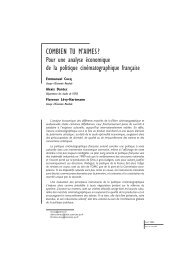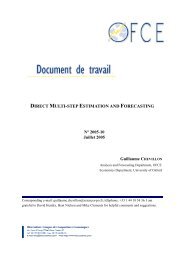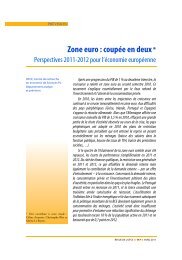N° 2005-09 Juin 2005 Guillaume Daudin* Jean-Luc Gaffard ...
N° 2005-09 Juin 2005 Guillaume Daudin* Jean-Luc Gaffard ...
N° 2005-09 Juin 2005 Guillaume Daudin* Jean-Luc Gaffard ...
Create successful ePaper yourself
Turn your PDF publications into a flip-book with our unique Google optimized e-Paper software.
Offshore Relocations and Emerging Countries’ Competition: Measuring the Effect on French EmploymentFor imports, the usual assumption is that of a substitution between domestic and foreignproduction in value — i.e. one euro of imports substitutes to one euro of domestic production— rather than in volume 13 — i.e. a pair of foreign shoes substitutes to a pair of domesticshoes. The assumption of substitution in value is not really restrictive as long as internationaltrade of France is predominantly oriented towards developed countries: in that case, theunitary price and quality of goods imported from abroad and produced domestically isroughly similar. As, in 1997, developed countries accounted for 79 % of French imports (75% of French exports), with figures reaching 90 % in many sectors, the value hypothesis is nottoo much of a problem the measure the global effect of international trade. However, thevalue hypothesis is much more a problem when one tries to measure the effect of French tradewith developing countries. Due to price differentials, substitution in volume is much moreplausible. Insofar as we are looking primarily into these effects, one should favour this latterhypothesis.There are other difficulties. The results are strongly influenced by the sign of the tradebalance. As a result, trade balance disequilibria are sometimes corrected to compute only thestructural effect of external trade on domestic employment. When this is the case, estimatesare based on theoretical balanced trade flows. Finally, the counterfactual situation used forcomparison is "autarky". The definition of autarky is very restrictive: it is assumed to have noimpact on the nature of goods produced, prices, wages, productivity and consumption. Tosum up, while this method has the advantage of simplicity, its drawbacks are numerous: lackof strong theoretical grounds, strong assumptions related to the counterfactual situation,assumption of homogeneity between foreign and domestic goods, use of an averagecoefficient rather than a marginal coefficient etc 14 .13 This opposition between value and volume is different from the usual one which takes into account theevolution of prices through time.14 See, for instance, Messerlin (1995) or <strong>Jean</strong> (2001) for a discussion.18








